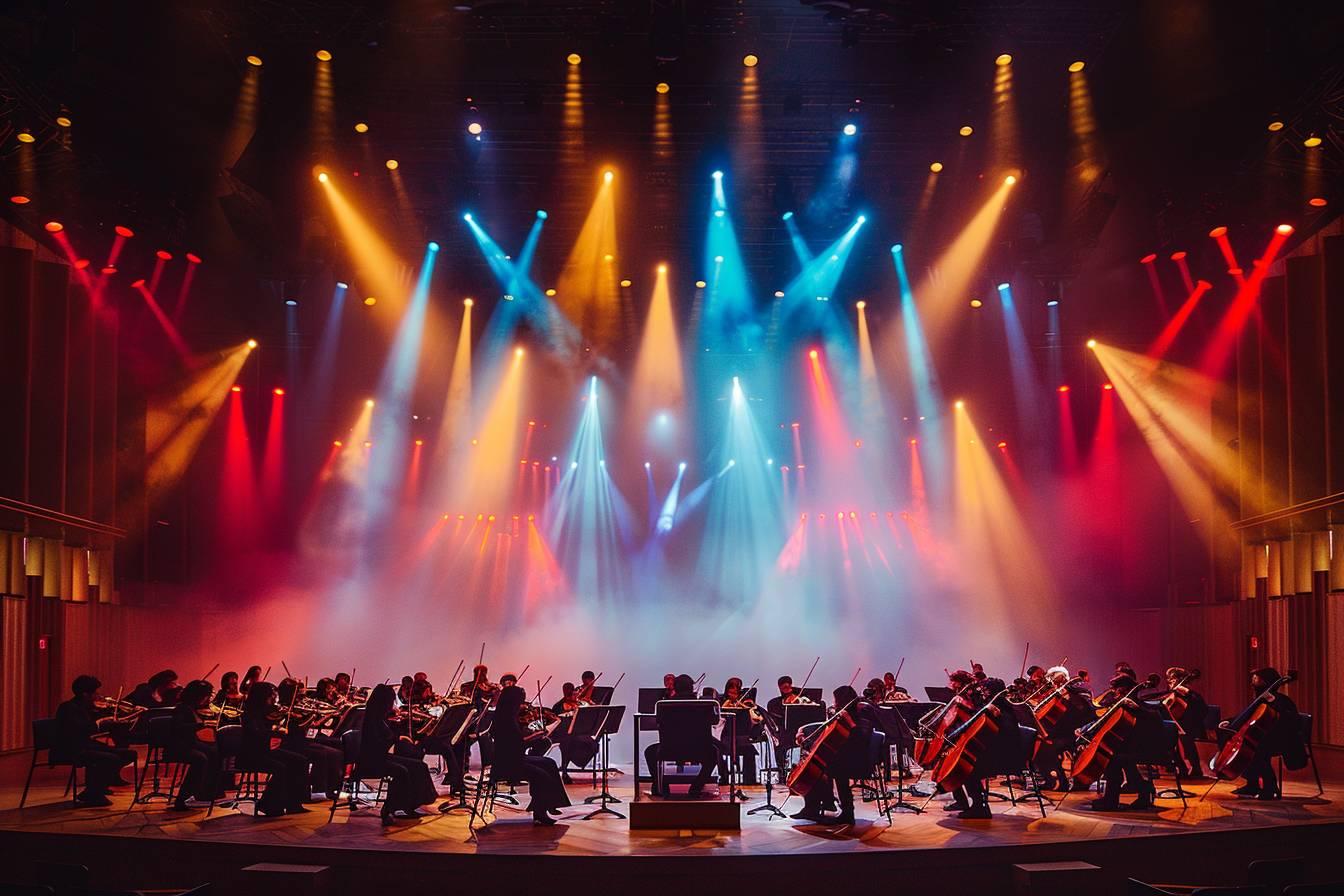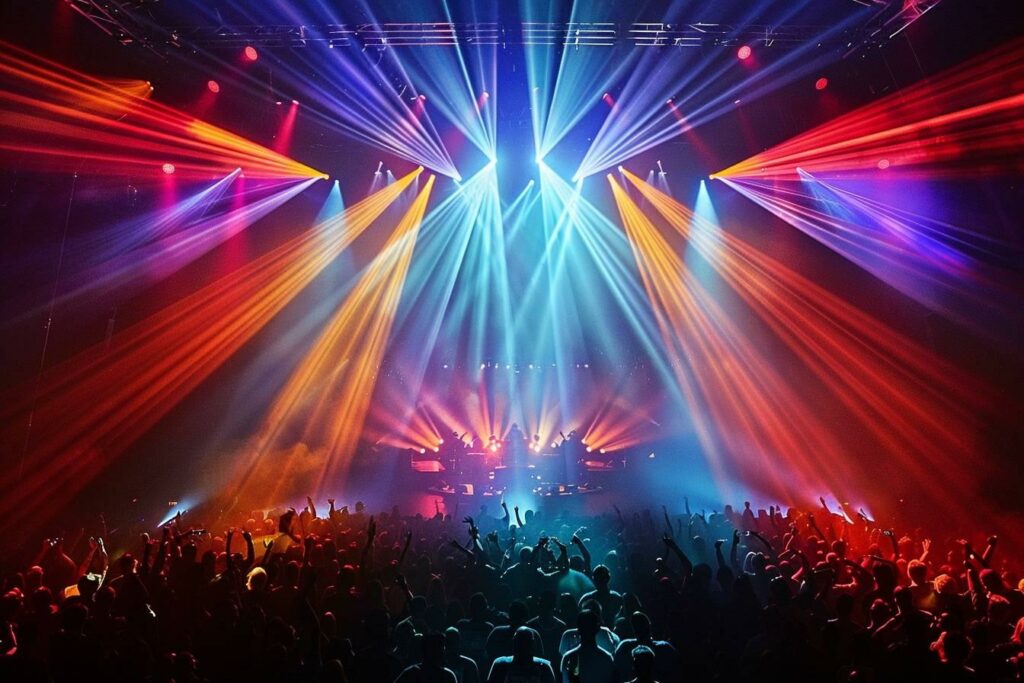The magic of a concert lies not only in the music, but also in the atmosphere created by the scenic lighting. Well thought-out lighting design can transform a simple show into an unforgettable immersive experience. Let’s delve into the subtle art of concert lighting and discover how it can sublimate a musical performance.
The importance of lighting in the concert experience
Lighting plays a crucial role in creating a unique atmosphere at a concert. It doesn’t just illuminate the stage, it tells a visual story that accompanies the music. Well-designed concert lighting can :
- Intensify the emotions conveyed by the music
- Guide the audience’s attention to specific elements of the performance
- Create an immersive atmosphere that transports the spectator
- Reinforce the visual identity of the artist or band
Lighting designers work closely with the artists to create light tableaux that reflect the essence of each piece. This synergy between sound and light is what transforms a simple concert into a complete sensory experience, leaving a lasting imprint on the audience’s memory.
Lighting can also influence the perception of time and space. Well-orchestrated lighting effects can make a small hall seem larger, or create intimacy in a vast arena. This manipulation of the environment by light contributes to the spectator’s total immersion in the artist’s musical universe.
Lighting techniques to create a captivating atmosphere
To create a captivating lighting atmosphere at a concert, lighting technicians have an arsenal of techniques at their disposal. Here are some of the most effective methods:
1. Dynamic contrast: alternating between moments of brightness and periods of darkness creates a striking contrast. This technique is particularly effective for highlighting changes in mood in music, for example, from an intimate verse to an explosive chorus.
2. Rhythmic synchronization: Coordinating light changes with the rhythm of the music amplifies the emotional impact. Stroboscopes pulsating to the beat of intense drums or waves of color undulating over a melodic passage create a visual and auditory symbiosis.
3. Emotional colorimetry: Each color evokes specific emotions. Using a chromatic palette adapted to each piece reinforces the desired atmosphere. For example, warm tones for romantic ballads or deep blues for melancholy pieces.
4. Special effects: The use of lasers, smoke or video projections can create spectacular moments. Used sparingly, these effects add an extra dimension to the visual experience of the concert.
| Technique | Desired effect | Example of use |
|---|---|---|
| Dynamic contrast | Accentuating mood changes | Transition from verse to chorus |
| Rhythmic synchronization | Reinforce the impact of the music | Stroboscopes on a drum solo |
| Emotional colorimetry | Evoke specific emotions | Red tones for a passionate song |
| Special effects | Create memorable moments | Laser to form band logo |
These techniques, when mastered, create a veritable visual symphony that elevates the concert experience to a new level. The art of stage lighting lies in finding the right balance between these different elements to support the musical performance without overpowering it.

Equipment and technologies for innovative concert lighting
Technological evolution has considerably expanded the possibilities forstage lighting. Lighting designers today have an arsenal of sophisticated tools at their disposal to bring their creative visions to life. Here’s an overview of the essential equipment for modern concert lighting:
LED spotlights: These versatile spotlights offer an almost infinite color palette and low energy consumption. Their flexibility allows rapid changes of color and intensity, essential for following the nuances of the music.
Servo headlamp: These motorized projectors can move, change color and pattern in real time. They are crucial for creating dynamic effects and following the movements of performers on stage.
DMX control consoles: These sophisticated consoles allow all lighting to be programmed and controlled live. They are the brains of the installation, ensuring perfect synchronization between music and lighting.
Video mapping systems: These technologies project images or videos onto irregular surfaces, transforming the stage into a giant canvas. They offer infinite possibilities for creating dynamic virtual sets.
Integrating these technologies into an innovative scenography pushes back the limits of creativity. Lighting designers can create unique visual experiences that remain engraved in the memory of spectators long after the concert is over.
Tips for optimizing your concert lighting
Whether you’re a freelance artist or a novice technician, here are a few tips for getting the most out of your concert lighting:
- Know your setlist: Plan your lighting design around the structure and mood of each song. Anticipate highlights to create memorable effects.
- Less is more: Don’t overload the stage with lights. Sometimes, a single well-placed light can have more impact than a multitude of spotlights.
- Play with shadows: Darkness is as important as light. Use shadows to create mystery and contrast.
- Adapt to the venue: Every venue has its own particularities. Take the time to understand the acoustics and architecture of the room to optimize your lighting installation.
- Communicate with the band: Establish a dialogue with the musicians to understand their vision and specific lighting needs.
By applying these principles, even with limited equipment, it’s possible to create an enchanting atmosphere that will enhance the musical performance. Concert lighting is an art that is perfected through experience and experimentation.
Concert lighting is much more than a simple illumination tool. It’s an artistic medium in its own right that, when mastered, can transform a concert into a total sensory experience. By combining creativity, technique and musical sensitivity, lighting designers create visual universes that amplify the emotion of the music and leave an indelible imprint on the audience’s mind. Whether you’re a performer, technician or spectator, understanding the importance of stage lighting will enable you to fully appreciate the magic that happens when music and light merge in perfect harmony.

